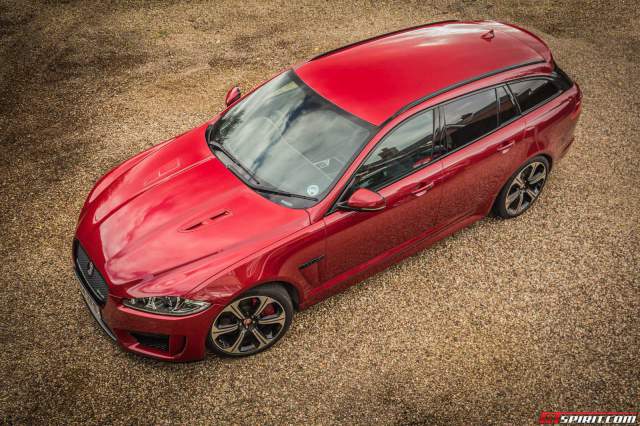
The modern automative marketplace almost certainly considers the Jaguar XFR-S Sportbrake a novelty. The popularity of SUV’s, Crossovers and MPV’s seems to far outstrip that of the humble estate car. Of course, that particular market trend only tells half the story when it comes to the XFR-S. It is more than just your bog standard estate car, as the many Nurburgring prototypes tended to suggest
We were recently given the chance to sample Jaguar’s first performance estate, the 2015 Jaguar XFR-S Sportbrake. The Jaguar XF was a product of the first stage of Jaguar recovery program, pursued so ruthlessly by its Indian financier, TATA. The XFR-S Sportbrake is likely the final swan song for a car that helped revive the ailing British brand. And what a swan song it is!
Design
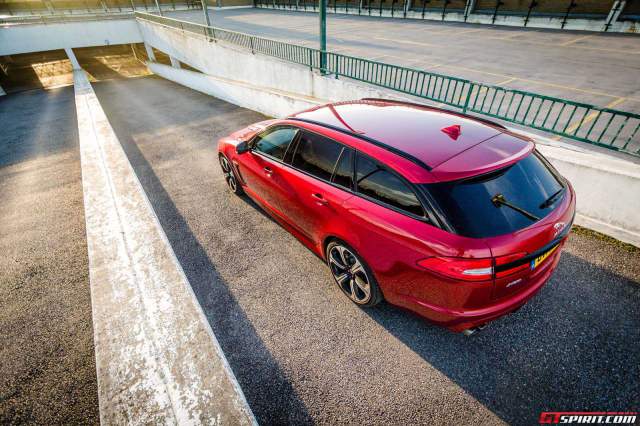
The design is familiar Jaguar. The Jaguar XFR-S Sportbrake gets that same stylish roof line together with the R-S elements that we’ve seen on the XFR-S Sedan and XKR-S that came before it. The central design lines appear to rise along the length of the car while the top line gently slopes down to meet it.
Our car gets Italian Racing Red paintwork. A colour we first discovered on the Jaguar F-Type V8 S last year. On the XFR-S it looks sensational, much better than the outlandish shade of blue that had been specced for all the media shots. Our example also benefited from a black painted grille, roof bar and window surrounds which comes as standard on this model. Other exterior paint options include Ultra Blue, Ultimate Black, Stratus Grey and Polaris White.

The R-S parts include a set of body-coloured bonnet vents and a deep carbon fibre front bumper at the front. Moving back, the side skirts are new, giving the Sportbrake a wider, more aggressive look. The rear bumper incorporates a carbon fibre diffuser which helps to channel the air from the rear of the car. The rear wing looks to have been retained from the standard Sportbrake, which is a good thing as a bigger spoiler would look out of place.
Personally, i’m not a huge fan of the six-spoke, 20-inch lightweight Varuna forged alloy wheels. However, they drew plenty of comments during my time with the car so i’m obviously a minority. Our example had a ceramic polish with gloss black accents, however, they are available in a variety of different grey’s and in solid gloss black.
Engine, Drivetrain and Chassis
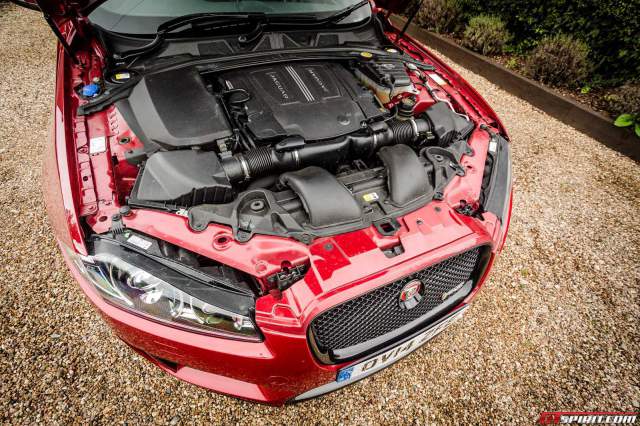
The engine should by now be familiar. The same unit is fitted to the XKR-S, XFR-S Sedan and the XJR. It is a 5.0 litre V8 unit pushing 550 hp at 6,500 rpm and 680 Nm of torque between 2,500 and 5,500 rpm. Whereas the market tends to lean towards turbocharging nowadays, the sound of a spooling supercharger under heavy acceleration sets the Jaguar apart from the rest.
Whilst it is well known that the 5.0 litre V8 has its origins with Ford; the unit Jaguar currently uses is completely redesigned for modern Jaguar models. The power is routed to the rear wheels through a Quickshift gearbox delivered from the Jaguar F-Type. On manual downshifts, the electronics automatically blip the throttle which causes the exhaust to crackle and pop.
With the emphasis on performance, the XFR-S Sportbrake benefit from increased suspension stiffness and spring rates by 30 per cent. Refinement of the suspension components took place on the legendary Nürburgring, the high-speed bowl at Nardo in Italy and in north Wales which tells you all you need to know about this performance estate.
Dynamic Mode is where you’ll notice most of the cars sporting character. Jaguar’s Adaptive Dynamics spring into play at the touch of a button. It controls vertical body movement, roll and pitch rates through the use of continuously variable dampers which adapt up to 500 times a second. Couple this with an electronic differential and clearly the Jaguar is a serious contender.
To match the sledgehammer performance, Jaguar have also revised the braking package. The Jaguar XFR-S Sportbrake gets 380mm front discs and 376mm rear discs with improved ventilation and cooling.
Interior
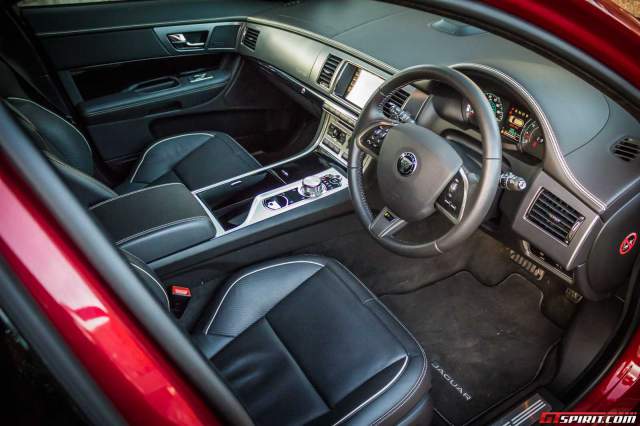
The interior of the Jaguar XF is arguably the weakest link. Nearing its eighth production year, the XF is starting to feel a little dated behind the wheel. Natural for any car given the pace of progress, however, the additions to the XFR-S Sportbrake give it an edge over the rest of the range. Behind the steering wheel of the Jaguar XF is still a luxurious place to be.
The XFR-S Sportbrake gets a new set of sports seats. Far from stripped out racing buckets, the seats are comfortable with plenty of cushioning. Ours were fully adjustable with buttons at the side of the seat and heating elements for added comfort. The leather feels soft and is finished with R-S branding.

The dash is all-leather with intersecting painted veneers. If there was ever a traditional Jaguar-specific complaint, its the Multi-Media System. Jaguar’s rivals do it better if we are honest. Of course, the next generation XF will likely get the XE’s brand new multi-media system. For now though, the XF is lumbered with a system that lags quite heavily.
Another part of the package that feels a little disappointing is the steering wheel. Given that this is a constant point of contact for the driver, the lack of update over the leather unit installed in the standard diesel Sportbrake sticks out. The paddle shifters are also identical to the diesel models. Fitted discretely to the rear of the steering wheel, they aren’t quite the showcase you would expect from a performance estate.
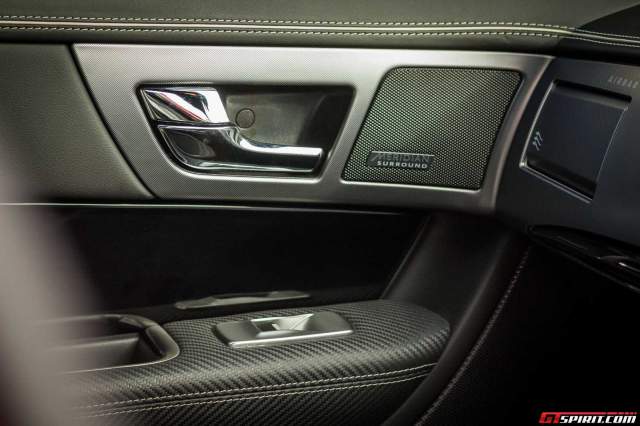
That said, the drivers immediate surroundings, steering wheel and paddle shifters included, work well.The Jaguar XFR-S Sportbrake still feels every bit as luxurious and special as you would expect. As the old adage goes; “if it isn’t broken, don’t fix it”.
The unique selling point for the XFR-S is the estate bodywork. The estate hatch adds extra legroom and headroom to the XF package, as well as extra storage space above the window line when the rear seats are up. Pull the seats down though and the XFR-S Sportbrake generates enough space for 1,675 litres.
On the Road
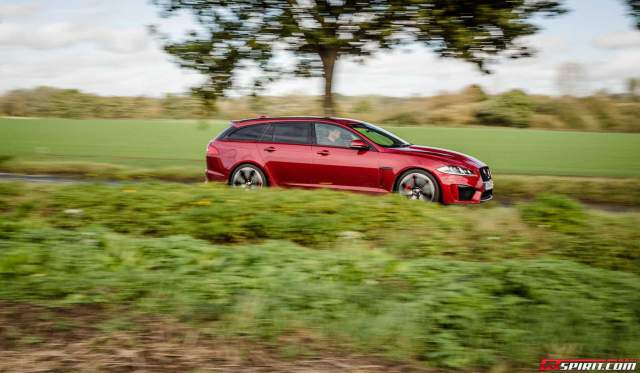
I took delivery of our demonstrator on a Monday. With a busy week ahead, I knew the usual 9-5 would provide me with plenty of insight into the character of the XFR-S Sportbrake. My Italian Racing Red example stuck out from the evening traffic like a sore thumb. It’s safe to say that, if you were to use an XFR-S Sportbrake on a day-to-day basis, you wouldn’t spot another on the opposite carriageway.
Pushing the open button on the key fob illuminates the front LED daytime running lights, as well as the door handles. A handy feature in the dark. Leaving the office behind, the leather surfaces of the Sportbrake are comforting. The seat and steering wheel warmers are an added bonus, quickly warming the two most vital parts of the cockpit. It doesn’t take long to get the seat set to the right position and the steering column features plenty of adjustability.
The ignition is button operated. Pushing the starter wakes up that V8 with a growl which subsides once the transmission selector shifts to drive. Evidently, in Auto mode, the exhaust baffles close at low RPM’s leaving a light rumble which all but disappears once the door is shut. The rear camera provides some rear visibility for reversing but it doesn’t make the side or rear mirrors redundant.

The fact that this is a large car is further reinforced when clearing the rain water from the rear windscreen. Push the lever, glance in the rear mirror and it is a good few seconds before the windscreen wiper drags itself across.
The obvious disadvantage to the supercharger lies in the economy rating. Jaguar quote a 22.2 EU MPG rating which seemed remarkably accurate during our experience, albeit only at consistent speeds during our commute.
Fast Jaguars tend to have a completely different character to the likes of Audi RS-cars and Mercedes-AMG sports-wagons. Whereas the German contingent are characterised by their refinement, the Jaguar feels more edgy. It squirms and wriggles at it puts the power down at the rear. Travel onto a white line in the rain and you will most likely feel the traction control cut in.
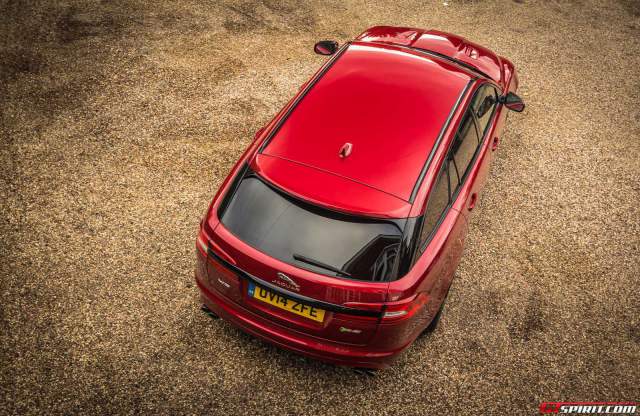
Whilst that might sound like a criticism, it really isn’t. The Jaguar has that raw, exciting character that seems to be missing in some of its German rivals.
Along our favourite country roads, the Jaguar feels quite composed considering the power. The ride is firm but never uncomfortable, it deals with potholes and rough surfaces well. In the dry, it feels confident and predictable; characteristics which make it easy for the driver to exploit most of the performance potential. Well judged seems the best way to summarise the XFR-S’ handling capability.
Conclusion
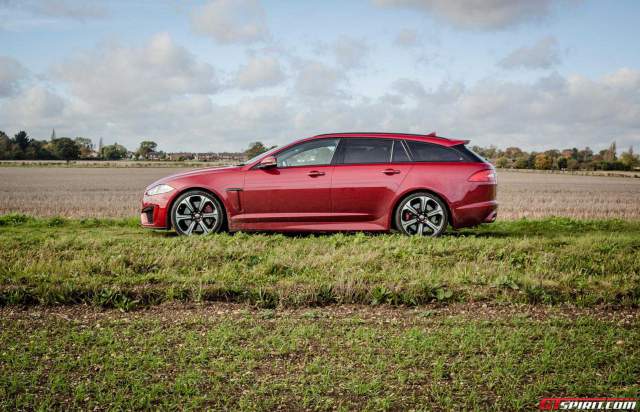
The Jaguar XFR-S Sportbrake is an odd proposition. Jaguar haven’t previously offered the 5.0 litre V8 for the XF Sportbrake model range. The Sportbrake has always been more of a diesel family car than its saloon counterpart. Yet, here we have a version with Jaguar’s most potent powerplant and an outlandish performance styling package.
Does it work? In many ways, yes! It fills a niche created by family life, for those with a sky-high budget and the need for plenty of space. Of course, that market place has some pretty compelling alternatives in the form of the Audi RS6 Avant and the Mercedes-Benz E 63 AMG. The choice is always likely to come down to personal preference more than an objective assessment of the technical prowess. The Jaguar will appeal to those that feel numbed by the German competition.
If it really does need to come down to an objective assessment though, the XFR-S Sportbrake passes with flying colours. It has the personality of a schizophrenic, feeling sedate and manageable in automatic modes with the ability to shred its rear tyres at the touch of a button. A trait that a handful of parents will find endearing.























































No comments:
Post a Comment